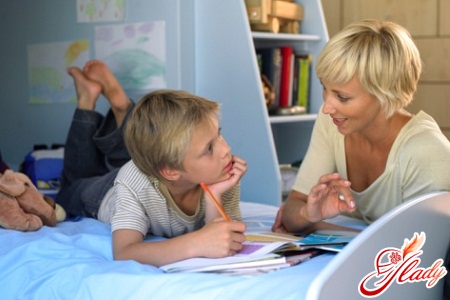 Lately, more and more often from parentsyou can hear that their child is being educated at home. Moreover, home schooling is becoming increasingly popular. Perhaps you are also thinking about transferring your child to home schooling? Home schooling for schoolchildren is quite possible, but for this, parents should know some of the features of this procedure. There are several varieties of this form of education, each of which, despite the general similarities, has its own distinctive features. This is what will be discussed in this article.
Lately, more and more often from parentsyou can hear that their child is being educated at home. Moreover, home schooling is becoming increasingly popular. Perhaps you are also thinking about transferring your child to home schooling? Home schooling for schoolchildren is quite possible, but for this, parents should know some of the features of this procedure. There are several varieties of this form of education, each of which, despite the general similarities, has its own distinctive features. This is what will be discussed in this article.
Home Education
Unfortunately, there are quite a lot of themchildren who, despite all their desire, simply cannot attend a regular comprehensive school due to their health condition. And, unfortunately, there are quite a few such children - according to statistics from the Russian Ministry of Health, today in our country there are almost 700 thousand disabled children of school age. And approximately 60% of all children are unable to attend school. And what should the rest of the children do? Not study at all? Of course, that is impossible. Study independently, but not receive any papers? But after all, everyone without exception needs a secondary education certificate! For such children, the only way out is home education, which will help them not to be left without a certificate of maturity. Currently, there are two forms of home education designed for disabled children:
- General Education
Those kids who are homeschooled,who study according to the general education program, study all the same subjects that their healthy peers study in a regular secondary school. And, in principle, after finishing school, both those children and others after completing their studies should have absolutely the same basic knowledge, of course, with an adjustment for the individual characteristics and abilities of each specific child. However, unlike school education, during home schooling the lesson schedule is quite flexible - the duration of lessons can be both shorter and longer: depending on the individual needs of the child and, of course, on his health. Teachers, as a rule, when coming to the child's home, prefer to cover several topics at once, which is why most often in one day there are no more than three lessons at a time. The standard scheme for home schooling of a sick child looks like this:
- Eight lessons - grade 4.
- Ten lessons - 5-8 class.
- Eleven lessons are class 9.
- Twelve lessons - 11 class.
After the child has completed his/her studiesgeneral program, the school will issue him a certificate indicating that the child has completed a comprehensive school, and this certificate is exactly the same as his classmates who study in a regular school according to a standard school.
- Supplementary training program
If the child is seriously ill, thenhis education is developed taking into account individual characteristics, according to an auxiliary program. In the event that a child graduates from school according to an auxiliary program, then after completing his studies he will be issued a special certificate, which will indicate the program according to which he studied.
How does this happen?
In order for a child to be homeschooled,Parents need to take some measures. First, you need to contact a pediatrician at a children's clinic, who will send your child to a special commission that will examine the baby and make an appropriate decision. If the commission finds that your child needs to be homeschooled, you will be given a special medical report. There is a list of illnesses for homeschooling of schoolchildren. After that, parents should contact the school principal and write an application of the appropriate form. You must attach the same medical report on the need for homeschooling to the application. If the child can be taught according to the general program, the teacher will give the parents a schedule of visits by teachers to the child. In the same case, if the child is seriously ill, the parents and teachers must draw up an additional educational program. This program must clearly state the subjects that the child will study, as well as the number of mandatory hours per week. Within a week after the parents have provided all the necessary documents, the school principal must issue a special decree for the school, which must specify the teaching staff that will teach the child, as well as the number of hours of study per week, and the frequency of certification of the child in academic subjects during the year. The school principal will give the child's parents a special journal in which teachers who come to the student's home must make notes on the time of classes with the child, the content of the material covered, and the child's academic performance. At the end of each school year, the child's parents must submit this journal to the general education institution during the final annual certification.
Family education
Another type of learning in which a childcan study at home without going to school - this is family education. In such cases, the child is educated at home not because his health condition forces him to such a measure, but because his parents want it that way. In this case, all knowledge is given to the child either by private teachers invited to him - tutors, or by the parents themselves, or as a result of self-education. Children who study in this way come to school only for midterm and final certification. In order to transfer the child to the form of family education, parents must also apply with a corresponding application to the director of the general education institution. The director will review the application and make a decision. An order will also be issued for the school, which will clearly spell out the schedule of midterm and final certification of the child. In what cases does it make sense to think about giving preference to the home form of education? Let's try to understand this issue:
What does that require?
As already mentioned, if the parents decidetransfer the child to home schooling, they must write an application to the school principal. However, before doing this, it is necessary to write an application with a request to consider this issue in the local department of the education department. A special commission will be created in the education department. This commission will include a representative of the department, the director and teacher of the school to which your child will be assigned, the child's teachers and coaches, the child himself, and other interested persons. If this commission deems it necessary and appropriate to educate the child at home, a decision will be made to assign the child to a specific school. And only after this, the school's pedagogical council will draw up a schedule for the child's midterm and final assessment.
Pros and Cons of Home Education
Home schooling has a number of positive and negative aspects. The positive aspects include:
- Flexibility of the educational process
Homeschooling allows schoolchildrenregulate the intensity of the load - either compress the volume of educational material, or, on the contrary, spend a longer period of time studying it than at school.
- Hope for yourself
When studying at home, the child does not havesuch an opportunity as at school to copy something from other kids. Therefore, he has to rely only on himself and his knowledge, which is not bad at all. After all, the ability to rely only on himself will help him out more than once in adult life.
- Selective training
Another good thing about home schooling for schoolchildren is thatthat the child has the opportunity to study in more detail the subjects that he is interested in. However, it should not be forgotten that the child will still have to pass all the compulsory academic subjects.
- Limiting the negative impact on children of their peers
Many parents justify their decisiontransfer a child to home schooling so that the child is not exposed to the negative influence of peers from disadvantaged families. In some ways, this is fair, but many child psychologists believe that as a result of this approach to education, children grow up unable to resist any negative influences. However, of course, home schooling for schoolchildren also has some negative aspects:
- Lack of children's collective
Because the child does not attend school, he does notwill not be able to acquire teamwork skills, will not be able to fully adapt socially. In any case, parents, before accepting such a responsible treatment, should carefully weigh all the positive and negative aspects! We recommend reading:








